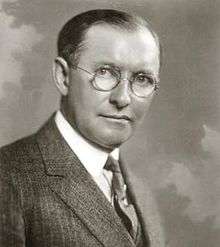James L. Kraft
| James L. Kraft | |
|---|---|
 | |
| Born |
James Lewis Kraft December 11, 1874 Stevensville, Ontario |
| Died |
February 16, 1953 (aged 78) Skokie, Illinois |
| Cause of death | Heart attack |
| Resting place | Memorial Park Cemetery, Skokie, Illinois |
| Nationality |
Canadian American |
| Known for | Kraft Foods Inc |
| Religion | Baptist |
James Lewis (J.L.) Kraft (December 11, 1874 – February 16, 1953) was a Canadian-American entrepreneur and inventor. Kraft was the first to patent processed cheese.
Life and career
Kraft was born near Stevensville, Ontario, Canada to parents Minerva Alice née Tripp (1848-1933) and George Franklin Krafft (1842-1914), a farmer.[1] He was of German origin. Kraft was educated in the Stevensville area (S.S. No. 9) and worked nearby at Ferguson's General store in Fort Erie, Ontario[2] from 1901 to 1902.[3]
After immigrating to Buffalo in 1902 he was forced out of cheese wholesaler Shefford Cheese Company by his partners.[4] Kraft began a new cheese business in Chicago in 1903 by selling cheese from a horse-drawn wagon.[5] Four of his brothers joined the company in 1909.[6] By 1914 J.L. Kraft & Bros. Company, which later became Kraft Foods Inc opened its first cheese manufacturing plant in Stockton, Illinois.[7] Kraft developed a revolutionary process, patented in 1916, for pasteurizing cheese so that it would resist spoiling and could be shipped long distances. The company grew quickly, expanding into Canada in 1919.[8] Kraft saw a large increase in business during World War I when the United States government provided cheese in tins to their armed forces.
J. L. Kraft served as the company's president from 1909 to 1953. Over the years, Kraft introduced many innovative products and used progressive marketing techniques to make his company one of North America's leading food producers. During that time the company introduced Velveeta in 1928 and Miracle Whip in 1933 at the Century of Progress world's fair. Kraft was an amateur jewelry maker; he also supported the Baptist Church and was a strong proponent of religious education for young people.
In the mid-1920s, Kraft began a venture to create a fashionable golf and tennis resort community in Lake Wales, Florida, along with Carl and Bertha Hinshaw. The Florida land bust and the stock market crash in October of '29 spelled the end of the Kraft connection. The Chalet Suzanne opened in the worst year of the Great Depression, 1931, and has been run by successive generations of the Hinshaw family ever since. Even though Kraft bowed out of the development, a 1920s era Spanish Revival house on the property continues to be called "The Kraft House".
J. L. Kraft and his wife Pauline had one daughter, Edith (c1916-2012).
The Krafts' home, built in 1922 by architect Paul V. Hyland, stands on North Kenmore in Wilmette, Illinois. He is interred in Memorial Park Cemetery, Skokie, Illinois. Kraft has living family members in Illinois and in Fort Erie.[9]
A few of Kraft's brothers, Charles Herbert, Frederick, Norman and John Henry, were executives in Kraft Foods.[10]
The Kraft family farm (at Bowen Road at Winger Road) in Stevensville, Ontario still exists as the area has remained agricultural.
References
- ↑
- ↑ Canadian historic marker
- ↑ http://www.forterietimes.ca/2015/03/30/famous-cheese-maker-has-stevensville-roots
- ↑ http://www.forterietimes.ca/2015/03/30/famous-cheese-maker-has-stevensville-roots
- ↑ http://www.kraftfoodsgroup.com/about/history/JLKraftBio.aspx
- ↑ Canadian historic marker
- ↑ Kraft Foods website
- ↑ Canadian historic marker
- ↑ http://www.forterietimes.ca/2015/03/30/famous-cheese-maker-has-stevensville-roots
- ↑ http://www.kraftfoodsgroup.com/about/history/JLKraftBio.aspx
External links
- From Cheese to Cheese Food: How Kraft persuaded Americans to accept cheese by divorcing it from its microbe-laden origins.
- Short biography of J. Kraft at Kraft Foods
- Long biography of J. Kraft at Kraft Foods Australia
- Biography at Harvard Business School's 20th Century American Leaders Database